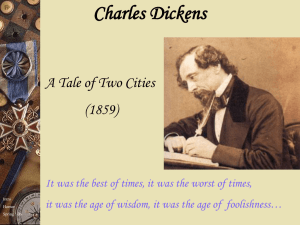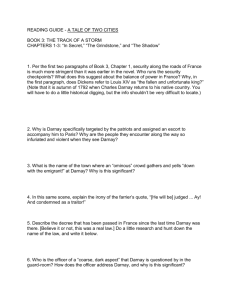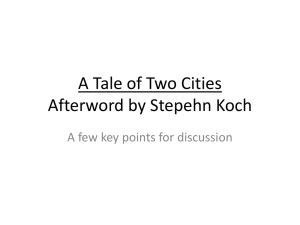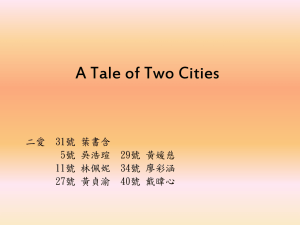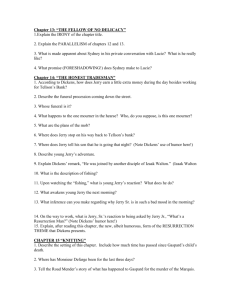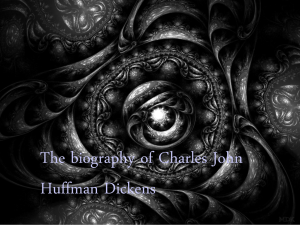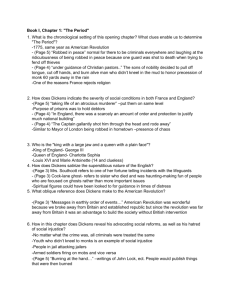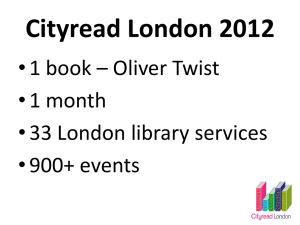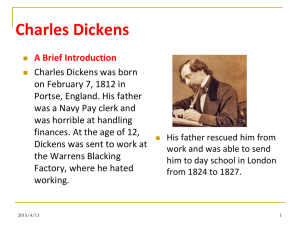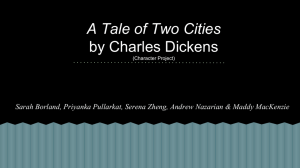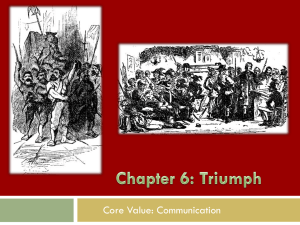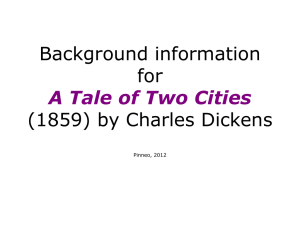A Tale of Two Cities - english2-decou
advertisement
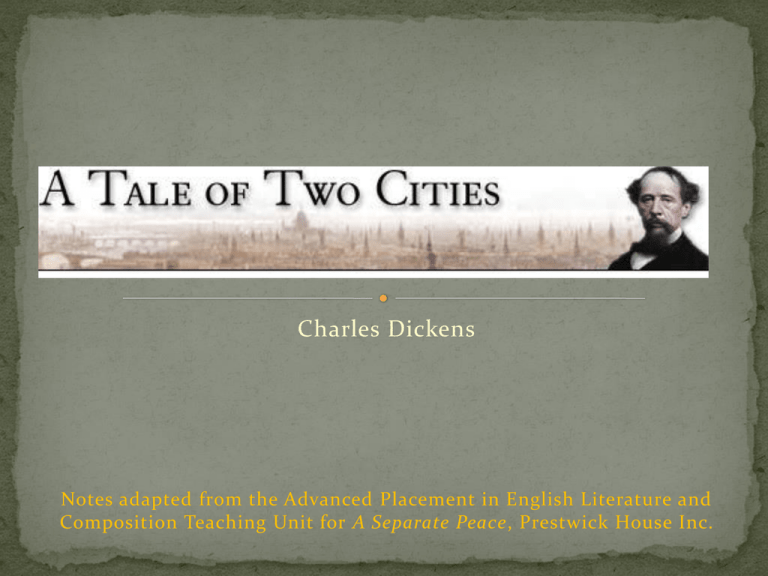
Charles Dickens Notes adapted from the Advanced Placement in English Literature and Composition Teaching Unit for A Separate Peace, Prestwick House Inc. By the end of this unit, the student will be able to: 1. 2. 3. 4. 5. Describe parallelism in Dickens’s style and identify examples of it in the novel. Explain the use of foreshadowing to heighten suspense and create interest. Recognize the difference between third-person and firstperson narration and indicate when the point of view changes. Explain the effect of point of view and the impact of changing point of view in different parts of the narrative. Trace the development of the major theme in this story— rebirth through sacrifice—as it applies to Dr. Manette, Sydney Carton, and Charles Darnay Examine the impact of serialization on the plot structure of the novel. 8. Discuss the novel as a commentary on late-eighteenth-century France and also as a commentary on the mid-nineteenth-century England. 9. Discuss the author’s use of exaggeration and caricature as a form of character development. 10. Support or refute the following thesis by citing examples from the story: The reader sees that, as a force of nature, love is more powerful than hate. 11. Respond to multiple choice questions and writing prompts similar to those that will appear on the Advanced Placement in English Literature and Composition exam. 12. Offer a close reading of A Tale of Two Cities and support all assertions and interpretations with direct evidence from the text, from authoritative critical knowledge of the genre, or from authoritative criticism of the novel. 7. Charles Dickens was born in Portsmouth, England in 1812. As the second of eight children in a very poor family, he lived a difficult childhood. Eventually, his father was sent to debtor’s prison, and Dickens himself went to work at the age of twelve to help pay off the family’s debt. This troublesome time scarred Dickens deeply and provided him with substantial material for such stories as Great Expectations, Oliver Twist, and David Copperfield. Steeped in social criticism, Dickens’s writing provides a keen, sympathetic chronicle of the plight of the urban poor in nineteenth-century England. During his lifetime, Dickens enjoyed immense popularity, in part because of his vivid characterizations, and in part because he published his novels in installments, making them readily affordable to a greater number of people. A Tale of Two Cities, originally published from April through November of 1859, appeared in a new magazine that Dickens had created called All the Year Round. Dickens started this venture after a falling-out with his regular publishers. Indeed, this period in Dickens’s life saw many changes. While starring in a play by Wilkie Collins entitled The Frozen Deep, Dickens fell in love with a young actress named Ellen Ternan. Dickens’s twenty-three-year marriage to Catherine Hogarth had become a source of unhappiness in recent years, and, by 1858, Hogarth had moved out of Dickens’s home. The author arranged to keep Ternan in a separate residence. Dickens’s participation in Collins’s play led not only to a shift in his personal life, but also to a career development, for it was this play that first inspired him to write A Tale of Two Cities. In the play, Dickens played the part of a man who sacrifices his own life so that his rival may have the woman they both love; the love triangle in the play became the basis for the complex relations between Charles Darnay, Lucie Manette, and Sydney Carton in A Tale of Two Cities. Moreover, Dickens appreciated the play for its treatment of redemption and rebirth, love and violence. He decided to transpose these themes onto the French Revolution, an event that embodied the same issues on a historical level. In order to make his novel historically accurate, Dickens turned to Thomas Carlyle’s account of the revolution. Contemporaries had considered Carlyle’s version to be the first and last word on the French peasants’ fight for freedom. author · Charles Dickens type of work · Novel genre · Historical fiction time and place written · 1859, London date of first publication · Published in weekly serial form between April 20, 1859, and November 26, 1859 narrator · The narrator is anonymous and can be thought of as Dickens himself. The narrator maintains a clear sympathy for the story’s morally good characters, including Sydney Carton, Charles Darnay, Doctor Manette, and Lucie Manette. Though he criticizes ruthless and hateful figures such as Madame Defarge, who cannot appreciate love, he understands that oppression has made these characters the bloodthirsty creatures they have become. point of view · The narrator speaks in the third person, deftly switching his focus between cities and among several characters. The narrator is also omniscient—not only revealing the thoughts, emotions, and motives of the characters, but also supplying historical context to the events that occur, commenting confidently upon them. tone · Sentimental, sympathetic, sarcastic, horrified, grotesque, grim setting (time) · 1775–1793 setting (place) · London and its outskirts; Paris and its outskirts protagonist · Charles Darnay or Sydney Carton major conflict · Madame Defarge seeks revenge against Darnay for his relation to the odious Marquis Evrémonde; Carton, Manette, Lucie, and Jarvis Lorry strive to protect Darnay from the bloodthirsty revolutionaries’ guillotine. rising action · The ongoing murder of aristocrats after the storming of the Bastille; Darnay’s decision to go to Paris to save Gabelle; the Defarges’ demand that Darnay be arrested climax · During a court trial, Defarge reads aloud a letter that he has discovered, which Manette wrote during his imprisonment in the Bastille and which indicts Darnay as a member of the cruel aristocratic lineage of Evrémonde (Book the Third, Chapter 10). In this climactic moment, it becomes clear that Madame Defarge’s overzealous hatred of Darnay can end only in death—either his or hers. falling action · The jury’s sentencing of Darnay to death; Darnay’s wish that Manette not blame himself; Carton’s decision to sacrifice his life to save Darnay foreshadowing · The wine cask breaking outside Defarge’s wine shop; the echoing footsteps in the Manettes’ sitting room; the resemblance between Carton and Darnay; Carton’s indication of this resemblance in a London court, which results in Darnay’s acquittal; Doctor Manette’s reaction after learning Darnay’s true identity Everything from mechanized This is a portion of the original manuscript for the opening stave of A Christmas Carol. printing presses, expanded railway lines, lower postage prices, and increased literacy all contributed to the publishing bonanza of 19th-century England. All of Dickens' novels were submitted to the printer in penand-ink (and blobs!). The typesetter would have to carefully decipher the sometimes illegible handwriting, written in the passion of the creative moment. The first typewriters came on the market in 1874, four years after Dickens‘s death. Themes are the fundamental and often universal ideas explored in a literary work. Theme = 1 word + author’s take Themes of Resurrection and Redemption: The two main themes of A Tale of Two Cities are the possibility of creating a new life from seemingly hopeless circumstances (resurrection) and the possibility of redemption and renewal. The theme of resurrection is first introduced in the title of Book One, “Recalled to Life,” and begins to develop with Mr. Lorry’s imagined conversation with the man who has been buried eighteen years. The man is, of course Doctor Manette, who is indeed resurrected from the metaphoric grave of a cell in the Bastille. As this statement implies, the doctor’s eighteen-year imprisonment has constituted a death of sorts. Lucie’s love enables Manette’s spiritual renewal, and her maternal cradling of him on her breast reinforces this notion of rebirth. The theme is further developed in Book Two when Charles Darnay is released from this charge of treason—a charge that would result in his death if he were convicted. Jerry Cruncher himself says he would understand the message “recalled to life” if it applied to Darnay. We are also introduced to Jerry’s “honest trade” as a resurrectionist—a person who takes fresh corpses from their new graves and sells them to medical students and researchers. This theme of resurrection is finally brought to completion with Darnay’s condemnation in France, his certain death, and his rescue by Sydney Carton, who dies in his stead. The night before his death, Carton recites to himself the opening of the Church of England’s funeral ritual, “I am the resurrection and the life…” And Carton is indeed Darnay’s resurrection. By delivering himself to the guillotine, Carton ascends to the plane of heroism, becoming a Christ-like figure whose death serves to save the lives of others. His own life thus gains meaning and value. Moreover, the final pages of the novel suggest that, like Christ, Carton will be resurrected—Carton is reborn in the hearts of those he has died to save. The theme of redemption is somewhat less developed, but is nonetheless important to the novel. Dr. Manette’s lost time in the Bastille is at least partially redeemed by his ability to assist Charles, and to keep him safe during his year’s imprisonment, ultimately effecting his first release. Darnay is arrested in England on charges of treason while attempting to find the family so terribly wronged by his father and his uncle and thus redeem his family’s name and honor. Jerry’s participation in an illegal—and possibly immoral—trade is redeemed by his ability to use information he gained robbing an empty grave to “convince” Barsad to cooperate with Carton. Mr. Lorry’s lonely life as a “man of business” is redeemed by his close friendship with the Manettes and Darnays. Carton’s wasted life is redeemed by his sacrifice. He is remembered and loved for generations and at least two generations of successful, productive men bear his name. Finally, France herself, as we are told during Carton’s prophetic vision at the end of the book, is redeemed, and a beautiful republic finally established. The theme of the necessity of sacrifice Connected to the theme of the possibility of resurrection is the notion that sacrifice is necessary to achieve happiness. Dickens examines this theme, again, on both a national and personal level. For example, the revolutionaries prove that a new, egalitarian French republic can come about only with a heavy and terrible cost—personal loves and loyalties must be sacrificed for the good of the nation. Most important, Carton’s transformation into a man of moral worth depends upon his sacrificing of his former self. In choosing to die for his friends, Carton not only enables their happiness but also ensures his spiritual rebirth The Tendency Toward Violence and Oppression in Revolutionaries While he supports the revolutionary cause, he often points to the evil of the revolutionaries themselves. Dickens deeply sympathizes with the plight of the French peasantry and emphasizes their need for liberation. Madame Defarge’s death by a bullet from her own gun—she dies in a scuffle with Miss Pross—symbolizes Dickens’s belief that the sort of vengeful attitude embodied by Madame Defarge ultimately proves a selfdamning one. Dickens’s most concise and relevant view of revolution comes in the final chapter, in which he notes the slippery slope down from the oppressed to the oppressor: “Sow the same seed of rapacious license and oppression over again, and it will surely yield the same fruit according to its kind.” Though Dickens sees the French Revolution as a great symbol of transformation and resurrection, he emphasizes that its violent means were ultimately antithetical to its end. Symbols are objects, characters, figures, and colors used to represent abstract ideas or concepts. The Broken Wine Cask With his depiction of a broken wine cask outside Defarge’s wine shop, and with his portrayal of the passing peasants’ scrambles to lap up the spilling wine, Dickens creates a symbol for the desperate quality of the people’s hunger. This hunger is both the literal hunger for food—the French peasants were starving in their poverty—and the metaphorical hunger for political freedoms. On the surface, the scene shows the peasants in their desperation to satiate the first of these hungers. But it also evokes the violent measures that the peasants take in striving to satisfy their more metaphorical cravings. For instance, the narrative directly associates the wine with blood, noting that some of the peasants have acquired “a tigerish smear about the mouth” and portraying a drunken figure scrawling the word “blood” on the wall with a wine-dipped finger. Indeed, the blood of aristocrats later spills at the hands of a mob in these same streets. Shadows and Darkness Shadows dominate the novel, creating a mood of thick obscurity and grave foreboding. An aura of gloom and apprehension surrounds the first images of the actual story—the mail coach’s journey in the dark and Jerry Cruncher’s emergence from the mist. As illustrated in the chapter with the appropriate subheading “The Night Shadows,” every living person carries profound secrets and mysteries that will never see the light of day. The vengeful Madame Defarge casts a shadow on Lucie and all of her hopes, as emphasized in Book the Third, Chapter 5. As Lucie stands in the pure, fresh snow, Madame Defarge passes by “like a shadow over the white road.” In addition, the letter that Defarge uses to condemn Darnay to death throws a crippling shadow over the entire family; fittingly, the chapter that reveals the letter’s contents bears the subheading “The Substance of the Shadow.” Madame Defarge’s Knitting Into her needlework she stitches a registry, or list of names, of all those condemned to die in the name of a new republic. But on a metaphoric level, the knitting constitutes a symbol in itself, representing the stealthy, cold-blooded vengefulness of the revolutionaries. As Madame Defarge sits quietly knitting, she appears harmless and quaint. In fact, however, she sentences her victims to death. Similarly, the French peasants may appear simple and humble figures, but they eventually rise up to massacre their oppressors. Dickens’s knitting imagery also emphasizes an association between vengefulness and fate, which, in Greek mythology, is traditionally linked to knitting or weaving. The Fates, three sisters who control human life, busy themselves with the tasks of weavers or seamstresses: one sister spins the web of life, another measures it, and the last cuts it. Madame Defarge’s knitting thus becomes a symbol of her victims’ fate—death at the hands of a wrathful peasantry. The Marquis The Marquis Evrémonde is less a believable character than an archetype of an evil and corrupt social order. He is completely indifferent to the lives of the peasants whom he exploits, as evidenced by his lack of sympathy for the father of the child whom his carriage tramples to death. As such, the Marquis stands as a symbol of the ruthless aristocratic cruelty that the French Revolution seeks to overcome. According to John R. Greenfield, in his An original illustration of Sidney Carton Dictionary of British Literary Characters, Dickens created 989 named characters during his career. As in all of his novels, Charles Dickens employs certain conventions and devices that were popular with his Victorian audience. Stock or Conventional Characters: Miss Pross-type: The blindly devoted nurse or governess, who has no life beyond the care of her charge and loves her charge, blindly, passionately, and possessively. Often, after the charge’s marriage, the governess meets a man and marries toward the end of the novel. Dickens’s readers may well have expected to see Miss Pross and Mr. Lorry marry at some point. Mr. Lorry-type: The “confirmed bachelor,” the “man of business.” As with the governess, Victorian novelists often had their confirmed bachelors fall in love and marry at the end of the story. Dickens challenges this convention, while also showing Mr. Lorry’s emotional side, even from his first meeting with Lucie. Jerry Cruncher-type: The hardworking, marginally honest (but loveable) representative of the lower class; uneducated, but wise; often harsh on the exterior but with a good heart; unwaveringly loyal. This is the character who helps the author supply comic relief through dialect or the expression of homespun reason. Lucie-type: Surprisingly, Lucie is not a fully developed, well- rounded character. She is the conventional daughter—obedient, loving, dutiful. Notice how it takes her no time at all to know and love her father and become his faithful servant. She is essentially weak (frequent crying and fainting spells) and always dependent on someone else. Plot Devices: The hidden and discovered letter: Often this is a diary (and sometimes a missing will or deed), but this was a popular device for discovering the past or hearing a character’s innermost thoughts. Identical twins switching identities: This plot device—often a comic device—dates back at least to Roman comedy playwright Plautus. Renaissance playwrights Shakespeare and Marlowe used this device in a number of their plays. It is the basis of Mark Twain’s The Prince and the Pauper. Even today, the identical twins switched at birth, separated at birth, or the identical strangers who meet one another is a popular film and television convention. Literary Coincidence: Victorian audiences demanded that all loose ends be connected at the end of the story. They particularly enjoyed revelations like the fact that: John Barsad is actually Miss Pross’s brother Solomon; Madame Defarge just happens to be the remaining sister of the injured family; Madame Defarge just happens to have married the former servant of the doctor summoned to help the sister and brother (remember, we are told that Defarge did not know his wife’s identity until the storming of the Bastille and his finding of the Doctor’s letter; The Doctor and Lucie meet the nephew (and son) of the Doctor’s tormentors on his journey to escape their torment; His daughter would actually marry into the family he has so vehemently denounced. Scenes of comic relief: Largely a dramatic device, but also popular in novels, these scenes either follow or precede scenes of intense action or emotion. For example, the scene in Jerry Cruncher’s house follows the Doctor’s mysterious discovery and escape from France and precedes Charles Darnay’s trial for treason. The scene in which Miss Pross complains to Mr. Lorry about the “hundreds of people” who invade their quiet home foreshadows the hoards of people who will threaten the family’s peace and happiness. And the scene in which Miss Pross and Jerry are discussing leaving France follows the tension of Darnay’s trial and Carton’s plans to save him, and precedes Miss Pross and Madame Defarge’s fight. Published in installments: The publication schedule would impact on the plot structure because Dickens would, first of all, want to end an installment on a suspenseful note; and, secondly, use the beginning of a new installment as an opportunity to introduce a new character, new plotline, or new setting. While most of the weekly installments First page of GREAT EXPECTATIONS included in the second weekly journal Dickens founded, ALL THE YEAR ROUND. consisted of a single chapter, a few were one or two chapters long. PBS has a great website about the author: http://www.pbs.org/wnet/dickens/ Revolutionary France http://chnm.gmu.edu/revolution/ Georgian England http://www.britainexpress.com/History/Georgian_index .htm
